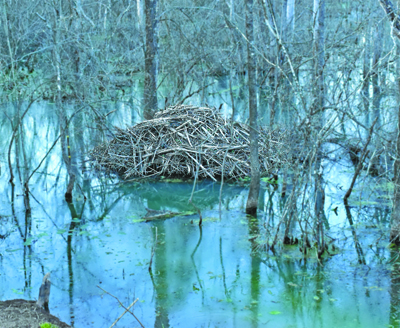Beavers dam Park Place
Resident irked by damage; dams now a Town issue
 Beavers built this lodge in the center of wetlands abutting Park Place subdivision.
Beavers built this lodge in the center of wetlands abutting Park Place subdivision.
While at least one resident complained about the animals’ destruction of trees and vegetation, near and downstream from where a very large lodge and dam have been built in wetlands just east and south of Farragut Town Hall, some of the neighborhood residents want the animals to be left alone.
Town officials put out a notice Monday, March 25, acknowledging the issue of tree damage was raised by the unnamed resident, and stated it had contracted with Varmint Busters — described as a “Tennessee Wildlife Resources Agency-certified animal damage control operator” — to trap and relocate the animals.
The Town stated in an informal press release that “in order to provide relief to the property owner, traps were placed near the edge of the wetland” the week prior.
“As the beavers have built (the dam and lodge), it has been very destructive,” Town Mayor Ron Williams said. “The potential damage, if we let it be, is that whole tree stand could be gone.”
Internet sources state an adult beaver can fell an 8-foot tree in as little as five minutes, or a 5-inch in diameter willow tree in three minutes. Wildernessclassroom.com went on to state that a pair of beavers could take down as many as 400 trees annually.
In addition to the vegetation destruction, there also was some concern by officials that the dam itself, which looks to be the length of a football field, could potentially contribute to future flooding.
“When they build (dams), it causes the water to go different ways,” said Williams, who added the stream running through that area of wetlands “had been moved 60 feet” with the dam’s construction.”
Town officials stated in the
information shared that one beaver had been trapped
over the weekend of March 22-24 and would be relocated to
an undetermined site away from the Town.
However, once apprised of the situation, Park Place resident and former Knox County Commissioner Mike Arms, whose property drops down toward the wetland area where the dam
and lodge are located, took issue with the Town’s decision to trap and relocate the animals, and noted the traps were initially
set on the neighborhood’s HOA property.
While Arms said the Town and staff “do an outstanding job,” and he, overall, has no complaint with the Town of Farragut, he believes “there is a difference of opinion in keeping the beavers versus removing them.”
In an e-mail last week to Town administrator David Smoak, which Arms said was a follow-up to a discussion the two had
earlier in the week, Arms thanked Smoak “for recognizing our neighborhood concern of
placement of beaver traps on
HOA property without advanced notice and without any ‘hazard’ posting when the dangerous traps were located near an
area that children frequently visit.”
Additionally, neither Arms nor HOA president Joan Bertini believe the beavers pose any real danger in the community, and also believe they should be left alone. “I walked the total
wetland area during the recent flooding and saw no results of flooding to residents or businesses from the beaver dam,”
Arms stated.
“I really don’t see a problem with the beavers,” said Bertini from the wetlands area last week. “If they can’t live in the wetlands, where can they live?”
Another separate issue, which Town officials noted, was the
traps initially placed apparently were sprung by a person or
persons unknown, which led to the traps being “temporarily
removed.”
At that occurrence, Varmint Busters notified Tennessee Wildlife Resources Agency to
report the tampering, which
Roy Smith, District 41 sergeant for Tennessee Wildlife Resources, said “is illegal” and could lead
to a citation.
“At the report of trap tampering, we responded,” Smith added. “We typically go out and make a presence with the hope we don’t have to cite anyone. We are just hoping that everybody will just get along.”
When asked about the issue late last week, Smoak confirmed plans remain to trap the beavers.
“They are on Farragut Town property and will be relocated,” he said. “They just need to be somewhere away from residential areas.”


